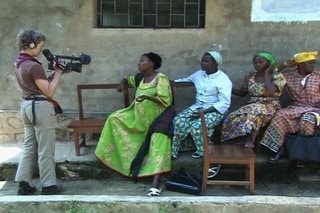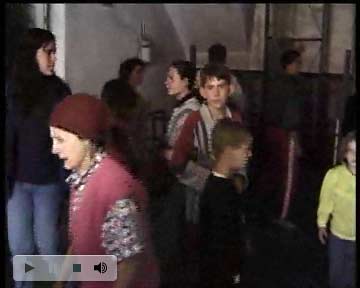by Ariel Dougherty
A quote from UNICEF fills the screen of the 2002 film, Women, The Forgotten Face of War: “A few decades ago women and children were five percent of war victims, today they are 90 percent.”
From war zones in Kosovo and Uganda, from Sudan and Georgia, it is women — young women, old women, and especially pregnant women — who are systematically, sexually brutalized. The brutalization is purposeful, meant to degrade and demoralize a population. Many are murdered; those who survive are frequently shamed within their own cultures.
To counteract these war horrors, media women armed with video cameras and other media tools have taken up the struggle to bring the women’s stories to larger audiences. They serve as a means of healing, and also as witnesses to the crimes against women.
Kosovar Women Speak of Ravages
Women, The Forgotten Face of War, an 85-minute documentary by Susan Muska and Greta Olafsdottir, starts in a refugee camp in Albania in 1999. The filmmakers interview Kosovar women who have fled their homes, have witnessed the murder of family members and speak of the ravages of their bodies by former neighbors and Serbian paramilitary. Despite the personal horrors, the women desire to return to their homes and reunite with dispersed family.
Over the course of three years, the filmmakers develop great rapport with their subjects and make numerous visits back to interact with the same Kosovar women. We see the Kosavars resettle in their villages, and follow the younger women back into their educational studies and their struggles to gain work. The emotional scars are deep and no part of their lives goes untouched. Human rights activists Sevdie Amheti, who in 1993 co-founded the Center for the Protection of Women and Children in Pristina, explains documenting these crimes, building a body of evidence that has been used by the International Criminal Tribunal on Former Yugoslavia in The Hague.
Six years after its completion, Women, The Forgotten Face of War, continues to play a powerful role. A screening in Pristina in June 2008 drew special attention. Filmmaker Susan Muska says “The screening in Pristina was especially moving because it was organized by Kosovar women of both ethnicities, by Igaballa Rugova of Kosovar Women’s Initiative, as part of a reconciliation and remembrance outreach project.” Nicole Slezak, a Georgetown University graduate student working with the Kosova Women’s Network, blogged and about the screening and posted video interviews of the filmmakers.
Building Communications Strategy and Action for Peace
A highly successful model use of media as a vehicle for peace and reconciliation has emerged from Uganda. Ruth Ojiambo Ochieng, has put her women’s information and communications technology (ICT) into active service for women devastated by war. Through ISIS-Women’s International Cross-Cultural Exchange (Isis-WICCE), where she serves as Executive Director, women testify to the crimes against them. Isis-WICCE videoed this story telling. The tapes are then played before policymakers.
Ochieng developed this three-step process into a dynamic strategy to create an effective link between Isis-Wicce, war survivors and policymakers. The multi-leveled strategy places information and communications technology at the center of collecting data, while relaying the women’s stories and moving policymakers to action. In a paper she delivered to the World Summit on the Information Society in Geneva in 2003, Ochieng said: “The expressions on the survivors’ face, the tears rolling down their cheeks, the mutilated parts of their bodies – none of these could be part of their stories. It was important to expose the visual magnitude of pain, to which mainstream media was mostly indifferent. The video camera became handy at this point. It became a powerful tool to project women’s suffering–physical, mental, psychological and economic.”
Ochieng was able to ensure that women were participants in peace talks between the Government of Uganda and the Lord’s Resistance Army for one of Africa’s longest civil wars. Her success in her home country has enabled her to extend her work to 50 countries. Centered on women’s rights and skills building for women in communications, she urges governments and international agencies to recognize the voices of women as central building blocks to sustainable peace in conflict zones.
The UNIFEM Trust Fund provided the support to turn the video testimonies into a completed documentary. Ochieng explained in a post on the UNIFEM site on November 24, 2000: “We need to expose these atrocities …. African women’s voices must be heard and I believe video documentation is one of the most effective ways to tell the stories of the crimes committed against women during war — stories that are rarely heard.” The completed video, A Lingering Pain, is available directly from Isis-Wicce.
Extensive Internet links to over 2,000 individuals and organizations enabled Isis-Wicce to share an unknown conflict with others across the globe. Sister organizations like the International Women’s Tribune Center arranged a showing of A Lingering Pain in conjunction with a meeting of the UN Commission of the Status of Women to discuss similar issues in the Democratic Republic of Congo.
One Woman: Film on Rape in Congo
The Greatest Silence: Rape in the Congo won the Special Jury Prize in competition at the Sundance Film Festival in January 2008. Written, directed and edited by Lisa F. Jackson, this 76-minute documentary is effecting significant change. A U.S. woman who had herself survived a rape, Jackson packed up her camera and headed to the Democratic Republic of Congo to use her own story to coax women in the Congo to tell their stories of rape.

Three-quarters through the movie, after countless horrific rapes were recorded, the filmmaker attended a church service in a large remote village. Dressed in their Sunday finest of bright-flowered and colorful patterned fabrics, a hundred women crowded into a community room after the service for a weekly support session. Jackson’s camera was on them. One by one, in a ritual storytelling and a purge of horror, they tell of their rapes. From the sheer number of women and the volume of the violence, the silence became loud — and clear. And because they were blazed onto video, these women’s stories from deepest Africa were assured a hearing in many halls of power.
Last March, on a world tour, the film opened at One World Human Rights Documentary Film Festival in Prague. Produced in association with HBO Documentary Films and the Fledgling Fund, The Greatest Silence played to a packed, standing-room-only audience for both its screenings. “In a show of outstanding generosity, the festival’s organizer, People in Need – founded by Václav Havel – is donating $10,000 to rape survivors in the Democratic Republic of Congo (DRC) and will be sending a humanitarian expert to the DRC. With the assistance of the Czech Delegation to the EU, they will also organize a screening of the documentary in Brussels for the European Commission,” reported the March newsletter of Women Make Movies, distributor of the documentary.
The Open Society Institute has funded Jackson to broaden her reach further with The Greatest Silence to affect more policy makers.
Empowerment
International Rescue Committee has a novel still photography project, A Global Crescdendo: Women’s Voices from Conflict Zones. It has been working with village woman in Côte d’Ivoire (Ivory Coast), Liberia, Sierra Leone and the Democratic Republic of Congo. Ann Jones, U.S. author (Women Who Kill, Winter in Kabul) and photojournalist, has been the advocate and teacher in this project. Her blog from West Africa is remarkable. In an entry on May 14, 2008 Jones wrote: “I teach them to point and shoot — only that — and then I turn them loose to snap what they will. I ask them to bring me some photos of their problems and their blessings… It takes the whole team to snap the first photos: one holds the camera, another points, another shoots.”
Jones explains in a video that is not photography skills per se that she is teaching. The goal is to give voice to these women. Previously denied access to basic technology like the radio, these women armed with digital cameras are treated in their villages with a new respect. At the end of each six-week project in a village, Jones selects two works of each woman for a community exhibition. In that forum, each woman speaks about her photographs. Until then some women had been forbidden to even look directly at the village chieftain, making this speaking both powerful and empowering.
Strategies to Focus on Women
| Universal Declaration of Human Rights Article 19: Everyone has the right to freedom of opinion and expression; this right includes freedom to hold opinions without interference and to seek, receive and impart information and ideas through any media and regardless of frontiers. |
Women media activists are working to build a global movement. The communications strategies created by Ruth Ojiambo Ochieng are vital learning lessons. As women strive to broaden the impact of their communications channels, the focus on women’s human rights becomes paramount and central.
Hundreds of projects of women are amplifying the voices of women on topics ranging from violence to reproductive justice. The U.S. women’s organization MADRE has a special Guide on the Crisis in the Middle East. Another women’s video team, Studio Mobile-Accent on Action, travels throughout the nation of Georgia to the remote villages of their country with their own woman-centered videos. The parallels of women’s media work in different corners of the globe are obvious, and leaders in women’s media are working on the financial challenges to elevate this work into a viable global network.
More than mere showcase portrayals, these media efforts are essential components of women’s human rights as codified in the Universal Declaration of Human Rights: the right of women to communicate and the right to have information.
Ariel Dougherty is associate producer for Lynn Hershman’s documentary/memoir on the Feminist Art Movement, 1968-2007, Women Art and Revolution. She is part of Women’s Media Equity Collaborative, a project funded by the Social Science Research Council that is conducting the first survey of women’s media justice organizations and analyzing sustainable funding models. Dougherty is a co-founder of Women Make Movies.
Also See: Does Working Girls Still Work? by Ariel Dougherty
Also See: Daughter, a play about women in the military, by Cassandra Medley in this edition of On The Issues Magazine

